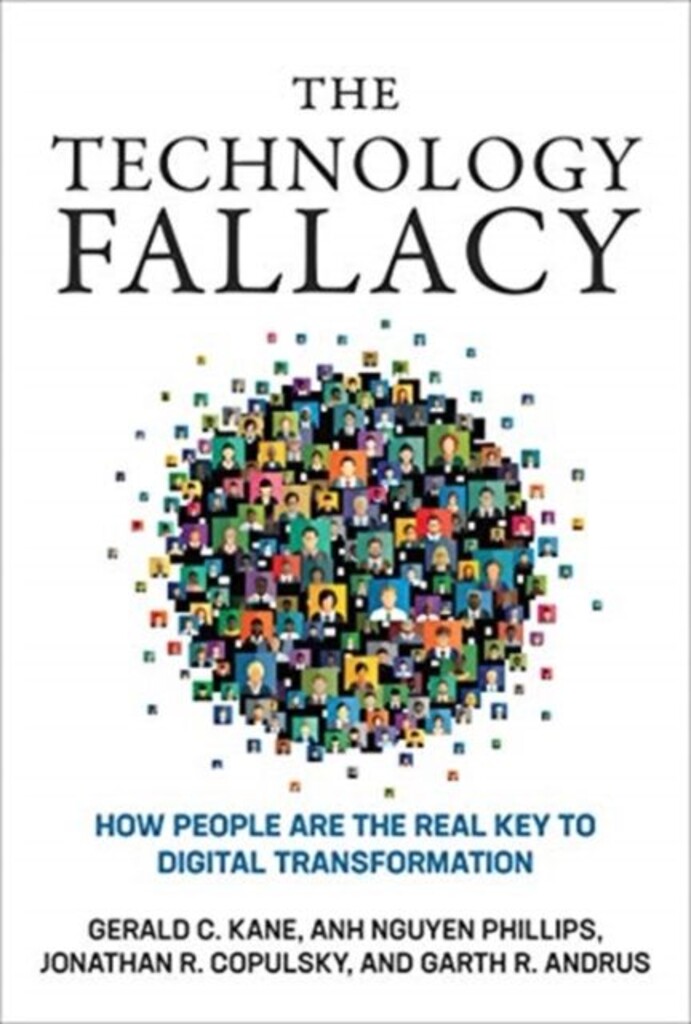
The technology fallacy : how people are the real key to digital transformation
Gerald C. Kane
Bok · Engelsk · 2019
| Medvirkende | |
|---|---|
| Omfang | x, 269 sider. : illustrasjoner, figurer
|
| Opplysninger | Intro; Contents; Series Foreword; Acknowledgments; Introduction: Digital Disruption-The Cyclone Has Arrived; About the Research; What to Expect; I. Navigating Digital Disruption; 1. Digital Disruption Is No Secret; The Gap between Knowledge and Action; Interpreting Survey Data; Why Aren't Companies Acting?; Competency Traps: What Got You Here Won't Get You There; "We Have Met the Enemy and He Is Us"; How Is Digital Business Different?; Disruption Is Here, It's Just Unevenly Distributed; You're Never Too Old to Adapt-Individually or Organizationally; 2. Digital Disruption Is Really about PeopleAdoption; Assimilation; Adaptation; Improving Adaptation through Absorptive Capacity; 3. Moving beyond the Digital Transformation Hype; Digital Maturity: Becoming a Digital Organization; What Is Different, What Is Not, and How to Tell the Difference; Why Digital Maturity?; Moving beyond the Hype; Measuring Digital Maturity; The Importance of Humility; More Opportunity than Threat; 4. Digital Strategy for an Uncertain Future; Lack of Strategy as a Key Barrier to Digital Maturity; Think Differently to Develop Digital Strategy; Think Long Term ... and Then Think LongerA Thought Exercise for Long-Term Strategic Thinking: Autonomous Vehicles; Reverse Engineering an Industry; 5. The Duct Tape Approach to Digital Strategy; Duct Tape and Digital Strategies; Discovering Hidden Affordances; Progressive Affordances: Walk before You Run; False Affordances: Digital "Placebo Buttons"; Collective Affordances; II. Rethinking Leadership and Talent for a Digital Age; 6. Digital Leadership Is Not Magic; The Challenge of Digital Leadership; Wilhelm Johannsen: Genotype vs. Phenotype; Fundamentals of Leadership; Diagnosing Mistakes in Understanding the Nature of Digital LeadershipWhat Stays the Same?; 7. What Makes Digital Leadership Different?; Digital Leadership Is in Demand; Skills for Digital Leaders; Transformative Vision and Forward-Looking Perspective; Digital Literacy; Change Oriented; Executing through Strong Leadership Skills; What Traits Do Leaders Need More Of?; Creating a Culture of Distributed Leadership; The Will to Transform; 8. The Digital Talent Mindset; Hard Skills, Soft Skills, and Hybrid Skills; Going beyond Skills to Mindset; A Continuous Learning Mindset; Technology Is Not Just about Millennials!Cultivate an Organizational Growth Mindset Aligned with Your Digital Strategy; Don't Just Train; Create Opportunities to Learn; 9. Making Your Organization a Talent Magnet; First, Make Good Use of the Talent You Have; Don't Lose the Talent Once You Have It; Passive Recruiting Exacerbates the Talent Threat; Locate Where the Right Digital Talent Can Find You; Look Outside Your Industry for Fresh Perspectives; Leverage Talent beyond Your Four Walls; Encourage Talent to Leak within Your Organization; 10. The Future of Work. - Why an organization's response to digital disruption should focus on people and processes and not necessarily on technology.Digital technologies are disrupting organizations of every size and shape, leaving managers scrambling to find a technology fix that will help their organizations compete. This book offers managers and business leaders a guide for surviving digital disruptions—but it is not a book about technology. It is about the organizational changes required to harness the power of technology. The authors argue that digital disruption is primarily about people and that effective digital transformation involves changes to organizational dynamics and how work gets done. A focus only on selecting and implementing the right digital technologies is not likely to lead to success. The best way to respond to digital disruption is by changing the company culture to be more agile, risk tolerant, and experimental.The authors draw on four years of research, conducted in partnership with MIT Sloan Management Review and Deloitte, surveying more than 16,000 people and conducting interviews with managers at such companies as Walmart, Google, and Salesforce. They introduce the concept of digital maturity—the ability to take advantage of opportunities offered by the new technology—and address the specifics of digital transformation, including cultivating a digital environment, enabling intentional collaboration, and fostering an experimental mindset. Every organization needs to understand its “digital DNA” in order to stop “doing digital” and start “being digital.”Digital disruption won't end anytime soon; the average worker will probably experience numerous waves of disruption during the course of a career. The insights offered by The Technology Fallacy will hold true through them all.A book in the Management on the Cutting Edge series, published in cooperation with MIT Sloan Management Review.
|
| Emner | ledelse organisasjonsendringer teknologi organisasjonspsykologi informasjonsteknologi endringsledelse bedriftsledelse organisasjonsutvikling
|
| Dewey | |
| ISBN | 0262039680. - 9780262039680. - 9780262545112
|
- Departementenes sikkerhets- og serviceorganisasjon: Departementenes bibliotek har 0 av 0 ledig (Oppdaterer)
- Forsvarets forskningsinstitutt: Biblioteket har 0 av 0 ledig (Oppdaterer)
- Handelshøyskolen BI - campus Oslo: Hovedbiblioteket har 0 av 0 ledig (Oppdaterer)
- Høgskolen i Østfold: Biblioteket - Halden har 0 av 0 ledig (Oppdaterer)
- Høyskolen Kristiania: Biblioteket Kvadraturen har 0 av 0 ledig (Oppdaterer)
- Norges handelshøyskole: Biblioteket har 0 av 0 ledig (Oppdaterer)
- Universitetsbiblioteket i Agder: Kristiansand har 0 av 0 ledig (Oppdaterer)